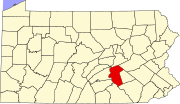South Hanover Township, Pennsylvania
It had two dry goods stores, two shoe stores, one millinery, a tailor shop, a hotel, an iron ore furnace, a flour mill, a wagon factory, a warehouse, a brick yard, and two resident physicians.
The early business activity was stimulated by the Union Canal, whose virgin barge trip occurred in 1828.
In 1845, Phillip Wolfsberger and Issac Hershey laid out the land and called it the village of Union Deposit.
The name came about due to the area's use as a place to deposit goods meant to be transported on the Union Canal.
Much of Union Deposit's early commercial success as a principal settlement in South Hanover Township stems from the past relationship the area had with a canal along the Swatara Creek.
Hoernerstown became a crossroads village from land originally owned by Major John Hoerner.
Hoerner acquired a land grant, which was later divided into farms with a small portion left for the village.
The southwestern and northern sections of South Hanover Township still remain primarily agricultural.
The bridge, restored by Hershey Enterprises in 1964, burned the night of September 3, 1966. Business and industry in this little town included a sawmill, grist mill, cabinet shop, store and schoolhouse.
The original Hanover Township was organized at a session of the Lancaster County Court in 1736–1737.
